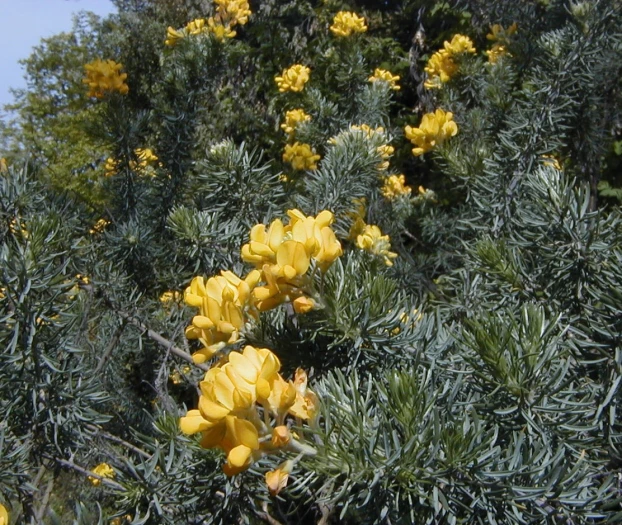Silver Broom
(Adenocarpus decorticans)
Silver Broom (Adenocarpus decorticans)
/
/

A. Barra
CC BY 3.0
Image By:
A. Barra
Recorded By:
Copyright:
CC BY 3.0
Copyright Notice:
Photo by: A. Barra | License Type: CC BY 3.0 | License URL: https://creativecommons.org/licenses/by/3.0 | Uploader: Cillas | Publisher: Wikimedia Commons | Title: Adenocarpus_decorticans.jpg | Notes: == Beschreibung == {{Information |Description=Madeira,_Palheiro_Gardens_-_Aeonium_arboreum_(Marokko) |Source=eigene Arbeit |Date=2008-3-24 |Author= [[User:Hedwig Storch|Hedwig Storch]] |Permission= |other_versions= }} [[Category:User:Hedwig Storch]] == |
















Estimated Native Range
Climate Requirements for Mableton, Georgia
| This Plant | Your Site | Plant Suitability for Your Location | ||
|---|---|---|---|---|
| • Precipitation | 14" - 50" | 51" | Aquatic | Aquatic |
| • High Temp. | 72°F - 96°F | 89°F | Your summer temperatures are normal for this plant. | Excellent |
| • Low Temp. | 12°F - 48°F | 32°F | Your winter temperatures are normal for this plant | Excellent |
This plant may not grow well at your location - your precipitation is too high.
Summary
Adenocarpus decorticans, commonly known as Silver Broom, is a deciduous shrub native to the mountainous regions of the western Mediterranean, specifically the Iberian Peninsula and North Africa. It thrives in open woodlands and rocky areas, where it contributes to the local ecology by stabilizing slopes and providing habitat for wildlife. This shrub typically grows to a height of 7-10 feet and a width of 5-9 feet, with a rounded form. The bright yellow, pea-like flowers bloom in abundance from late spring to early summer, resembling those of the common Broom, to which it is related. The flowers are quite showy and attract pollinators such as bees. Silver Broom is also notable for its greenish-gray bark that peels away in strips, adding textural interest to the garden.
Silver Broom is valued for its drought tolerance, making it suitable for xeriscaping and low-maintenance gardens. It is also used for slope stabilization and erosion control due to its robust root system. In cultivation, it prefers full sun exposure and can tolerate a range of soil types, provided they have good drainage. While it does well in peaty soil, it can also adapt to less fertile conditions. The plant is considered hardy in temperate regions, such as the South of England, and can withstand occasional cold spells. However, it may require protection from severe frosts in colder climates.CC BY-SA 4.0
Silver Broom is valued for its drought tolerance, making it suitable for xeriscaping and low-maintenance gardens. It is also used for slope stabilization and erosion control due to its robust root system. In cultivation, it prefers full sun exposure and can tolerate a range of soil types, provided they have good drainage. While it does well in peaty soil, it can also adapt to less fertile conditions. The plant is considered hardy in temperate regions, such as the South of England, and can withstand occasional cold spells. However, it may require protection from severe frosts in colder climates.CC BY-SA 4.0
Plant Description
- Plant Type: Shrub
- Height: 7-10 feet
- Width: 5-9 feet
- Growth Rate: Moderate
- Flower Color: Yellow
- Flowering Season: Spring, Summer
- Leaf Retention: Deciduous
Growth Requirements
- Sun: Full Sun
- Water: Low, Medium
- Drainage: Medium, Fast
Common Uses
Border Plant, Deer Resistant, Low Maintenance, Showy Flowers
Natural Habitat
Mountainous regions of the western Mediterranean, specifically the Iberian Peninsula and North Africa
Other Names
Common Names: Flatpod, Rascavieja
Scientific Names: Adenocarpus decorticans, Adenocarpus speciosus, Adenocarpus boissieri, Adenocarpus decorticans var. planifolius, Adenocarpus decorticans subsp. speciosus, Adenocarpus decorticans var. speciosus
GBIF Accepted Name: Adenocarpus decorticans Boiss.